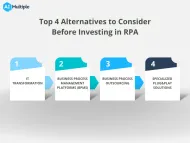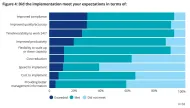Guide to RPA's Benefits in Analytics in 2024
We had explained RPA extensively in layman’s terms and outlined RPA benefits. As an excellent data aggregator, one of the frequently cited benefits of RPA is improved analytics and big data analytics which has been a priority for executives for the past decade. However, the benefits of RPA to analytics are limited to data federation as it enables multiple databases to function as one.
How does RPA contribute to analytics?
We should consider the analytics funnel above to see where RPA can contribute. Bots have essentially 2 critical functions from a data standpoint:
- Create meta data: As they complete tasks, they record their progress and the issues they face for diagnostic purposes. This data can be used for both the client or the RPA provider to identify RPA bugs and improve bot performance.
- Enable access to data in legacy systems: Since they overtake tasks that require interfacing with legacy systems, they make previously difficult to access data accessible. This can transform data collection capabilities of enterprises, especially those that depend on legacy systems.
Therefore, bots do not essentially improve analytics capabilities but aid in data collection. Even RPA vendors agree with this, underlining that core benefit of RPA is in data federation: the capability to collect data from many different sources and aggregate it in an easy-to-analyze format.
How does data federation contribute to company performance?
Firstly, data federation should not be a major concern for an SME or startup. However for large companies, it is a major concern as legacy systems historically held large companies back in terms of easy access to data. Now with access to granular data about processes, large companies can reap 2 important benefits:
Process optimization thanks to process mining
Granular data about processes can help identify bottlenecks and inefficiencies, enabling corporations to increase both speed and efficiency of the process. Furthermore, it makes dissemination of best practices easier. Since process flows can easily be visualized with the help of data, process flows in different regions can be compared to find the best processes for the whole company. For example, in one of process mining case studies, Piraeus Bank optimized their loan application processes from 35 minutes to 5 minutes, thanks to process mining technology.
For complex inter-related processes, machine learning techniques could be used to find optimizations that analysts could easily miss. Here are some examples from PwC:
Machine learning might come up with the suggestion that ordering material X from supplier A in the week of Christmas instead of the first week in January will result in a 50% improvement in order fulfilment in January. You could change the RPA robot setting in line with this suggestion to make sure orders to the relevant suppliers are placed during Christmas week, while your staff are on vacation. Apart from its ability to generate simple correlations, machine learning combined with today’s computing power is increasingly capable of identifying unknown relationships within multiple business processes. For instance, it can potentially correlate procumbent processes with sales processes to analyze directly what supply chain management actions need to be taken to improve sales.
Process simulation
Some major decisions like outsourcing, workforce reductions or expansions are made haphazardly, based on urgencies without considering future implications. Such decisions tend to have long-lasting impact because once a process is outsourced or its headcount increased, it is difficult to roll-back such decisions due to risk averseness inherent in humans. Managers, especially those in well performing companies, would like to see how rolling back such changes will not impact operations. Process simulation provides an answer. By simulating how a process flow will be impacted by changes, analysts can show the impact of major changes on the process. RPA systems can provide the necessary data for such simulations. RPA can have other fundamental benefits for cost management and elimination of manual errors as we outlined in our comprehensive list of RPA benefits.
For more on RPA
To explore RPA and its use cases in detail, feel free to read our in-depth articles:
- Top 100+ RPA Use Cases / Projects / Applications/ Examples
- 11 Steps to Successful RPA Implementation
- 21 RPA Pitfalls & Audit Checklist to Tackle Them
If you still have any questions about RPA, feel free to download our in-depth whitepaper on the topic:
And if you believe your business will benefit from an RPA solution, feel free to scroll down our data-driven list of RPA vendors.
And let us guide you through the process:

Cem has been the principal analyst at AIMultiple since 2017. AIMultiple informs hundreds of thousands of businesses (as per similarWeb) including 60% of Fortune 500 every month.
Cem's work has been cited by leading global publications including Business Insider, Forbes, Washington Post, global firms like Deloitte, HPE, NGOs like World Economic Forum and supranational organizations like European Commission. You can see more reputable companies and media that referenced AIMultiple.
Throughout his career, Cem served as a tech consultant, tech buyer and tech entrepreneur. He advised businesses on their enterprise software, automation, cloud, AI / ML and other technology related decisions at McKinsey & Company and Altman Solon for more than a decade. He also published a McKinsey report on digitalization.
He led technology strategy and procurement of a telco while reporting to the CEO. He has also led commercial growth of deep tech company Hypatos that reached a 7 digit annual recurring revenue and a 9 digit valuation from 0 within 2 years. Cem's work in Hypatos was covered by leading technology publications like TechCrunch and Business Insider.
Cem regularly speaks at international technology conferences. He graduated from Bogazici University as a computer engineer and holds an MBA from Columbia Business School.
To stay up-to-date on B2B tech & accelerate your enterprise:
Follow on

Comments
Your email address will not be published. All fields are required.